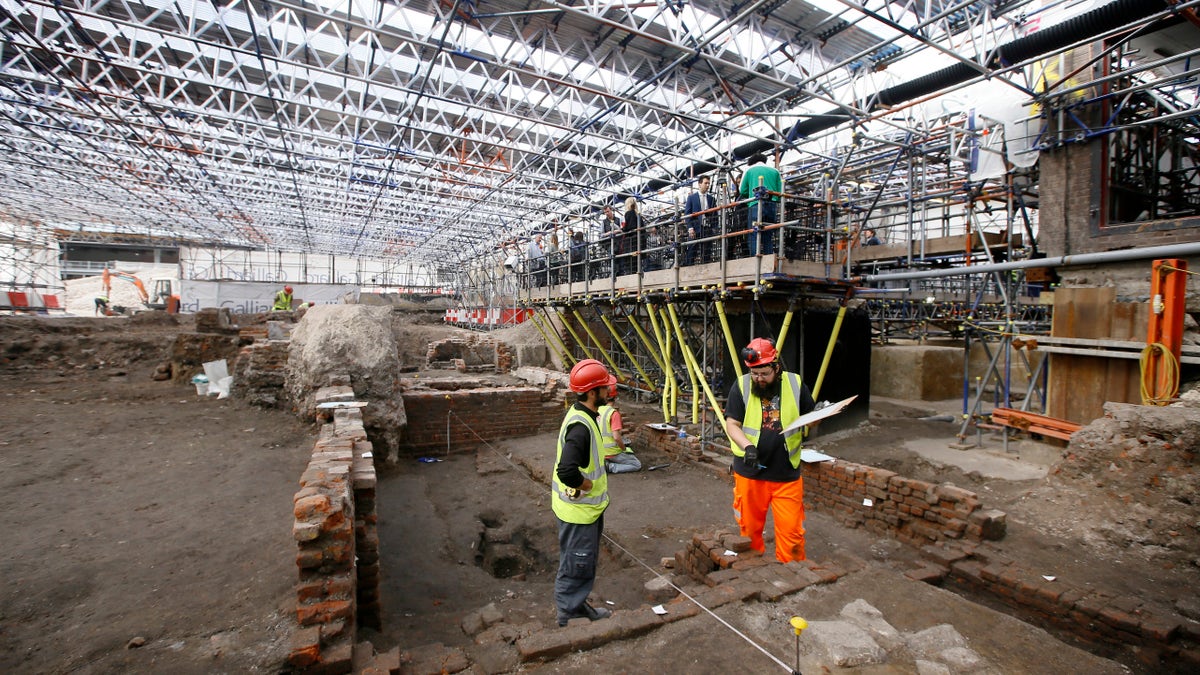
Archaeologists work on the exposed remains as the site of Shakespeare's Curtain Theatre is excavated in Shoreditch in London, Tuesday, May 17, 2016. (AP Photo/Kirsty Wigglesworth)
LONDON — London's relentless building boom has dug up another chunk of the city's history — one with a surprise for scholars of Shakespearean theater.
Archaeologists are excavating the remains of the Curtain, a 16th-century playhouse where some of the Bard's plays were first staged, before a new apartment tower sprouts on the site. Unexpectedly, the dig has revealed that the venue wasn't round, like most Elizabethan playhouses. It was rectangular.
That came as a surprise, because the best-known fact about the Curtain is that Shakespeare's "Henry V" was first staged here — and the play's prologue refers to the building as "this wooden O."
"This is palpably not a circle," Julian Bowsher, an expert on Elizabethan theaters, said during a tour of the site Tuesday.
The discovery has made Bowsher rethink some of his ideas about Tudor playhouses. He suspects that the Curtain — unlike the more famous Globe and Rose theaters — wasn't built from scratch, but converted from an existing building.
"Out of the nine playhouses that we know in Tudor London, there are only two that have no reference to any construction," he said — including the Curtain. "It's beginning to make sense now."
Where does that leave "Henry V"? Heather Knight, senior archaeologist at Museum of London Archaeology , said the play may still have premiered at the Curtain in 1599, but without the prologue.
"There's a school of thought now that says prologues were actually a later addition," she said.
The Curtain's remains were uncovered in 2011 on a site earmarked for development in Shoreditch, a scruffy-chic, fast-gentrifying area on the edge of London's financial district.
Archaeologists began excavating intensively last month, before construction of a 37-story luxury apartment tower and office complex named — with a nod to its heritage — The Stage.
They will keep digging until the end of June, and visitors can book tours of the excavations as part of events to mark this year's 400th anniversary of Shakespeare's death.
The site's developers have promised to keep the foundations of the historic theater on public view and to build a visitor center to display some of the archaeologists' finds. These include clay pipes that were used to smoke tobacco — introduced to Britain from North America in the 16th century — and a bird whistle which may have been used as a theatrical special effect. It could have featured in the scene in "Romeo and Juliet" — performed at the Curtain — in which the heroine reassures her lover that "it was the nightingale, and not the lark" that he'd heard.
Knight says the Curtain site "has probably the best preserved remains of any of the playhouses we've looked at."
The dig has uncovered the outline of a rectangular venue about 100 feet (30 meters) by 72 feet (22 meters) that could hold about 1,000 people. Workers have uncovered sections of the theater's gravel yard, where "groundlings" who had bought cheap tickets stood, and segments of wall up to 5 feet (1.5 meters) high.
The new building that will rise on the site — where apartments are being offered starting at 695,000 pounds ($1 million) — is part of a construction boom, fueled by London's sky-high property prices, that is transforming large tracts of the city. In the process, it is creating something of a golden era for London archaeology.
Nearby, work on the new Crossrail transit line has uncovered everything from 14th-century plague victims to Roman sandals.
Knight says the Curtain dig is filling in the picture of one of the oldest and least-known London playhouses, which served as a base for Shakespeare's troupe, the Lord Chamberlain's Men, between 1597 and 1599.
"This will give us real insight into these early playing spaces," Knight said. "It will help us understand the type of building that playwrights were writing for as well as performing in.
"It will also help us understand what type of audience was attending performances in these buildings. And also it'll fill in those gaps that are missing from the historical record."
